Dear Member,
As the weather cools down and we head into winter I wanted to reflect on some of the work completed over the last few months and also give you an insight into some of our plans for the winter and strategies for next year. The golf course has really moved along nicely this summer post the summer cultural works and this is a trend that will continue if we continue to commit to our maintenance programs.
Greens, Ante Greens & Tees – (Bentgrass) Overall, the surfaces are performing well. Thankfully, we’ve had some favorable temperatures in November this year, especially when comparing them to last year.
As touched on during previous reports our organic matter management strategy next year will be the key to keeping these healthy and improving, our current levels are too high and I will need to be mindful of this as we go through winter, extended periods of rainfall will increase surface moisture and in turn disease pressure, algal build up and threat of reduced turf density.
The 8mm needle tine will continue to keep the surface open to prepare for this period, which will inevitably come. Our organic layer and increased rounds have seen a decline in root depth and mass, whilst this isn’t uncommon throughout periods of the year it is something we need to be mindful of. The spacing out of next year’s closure periods will allow us to start to get on top of this issue. At present it’s very evident to see the correlation between moisture levels, firmness and surface performance. The drier we can keep them, the better they perform. That said, with the growing organic levels we have to be mindful of hydrophobicity and the disconnect between surface moisture and rootzone moisture.
Nematode populations are increasing and the increased organic layer plays a part in controlling these successfully as certain chemicals and biological control options have to be moved to certain areas within the rootzone to get to where the microscopic parasite feeds, the increased organic layer reduces the efficacy of how these products get to their intended places.
The teeing areas have again been a struggle to maintain turf health and density, this will be exaggerated as we move through the cooler months. whilst golf rounds will reduce so will recovery temperatures. I again ask you to ensure you use the area where the markers are placed and have some understanding around marker positions. Turf density is so important, any voids become vulnerable for weed ingress, particularly the problematic poa annua.
DECEMBER 2022
Below I’ve tried to highlight and show our accumulation of organic matter, this layer
plays a very important part in the turf’s health and performance. This also highlights the requirement and importance of topdressing on a regular basis. The key is to maintain the dilution of this layer at the same rate it generates. Balancing these agronomic factors is one of the keys to the longevity of healthy surfaces.
This highlight’s increasing organic levels within our bentgrass surfaces as they’ve
established. With 3 closure periods next year this allows us to start reducing this layer to
promote a healthier, firmer surfaces.

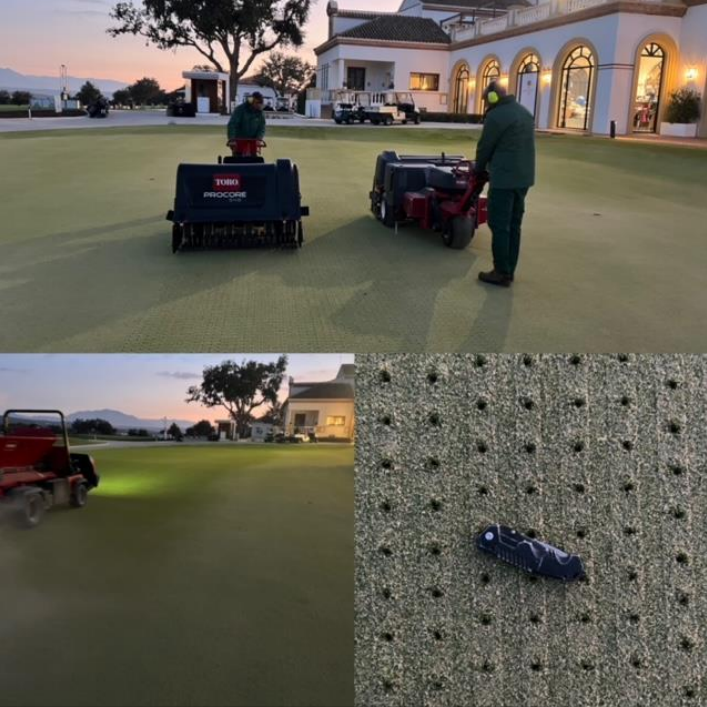
2021

2022

Two photos from the start of September with greens presenting well.

Fairways and Roughs (Bermuda)
The Bermuda turf has improved significantly throughout the 2nd half of the year. We have continued to refine the surfaces after the main cultural works at the end of May with light verticutting and topdressing. The surfaces have never been tighter and more dense than we’ve had them throughout the last few months, which is very positive.
Mowing heights have gone up a fraction at the end of october just to protect the turf moving into the cooler temperatures. Good defintion is still evident but as it cools down we’ll lose a bit of this, mainly in the traffic areas as the growth activity reduces. When we evaluate the performace of the turf this year it is all postive but I am still confident that this will improve further next year if we comitt to our maintenance programs.
Weed ingress has been a challenge this year with some chemicals being removed from the market so contiual trials will be ongoing to find alternative solutions. Having completed a full year here now I have gained further knowledge of the site and seasons and I see ways to improve on what we have done this year. These are most notably around fertility inputs and chemical timings. Next year I will look to increase granular
inputs and top up with foliar feeds more to give more consistent growth. Given the high spec drainage and inert sand cap the retention of nutrients has been a challenge at times, this will get better as we go through the years and we create a more stable rootzone.
One of the dissapointing things from this year has been the minimal changes to the storm patch up sod. We were hoping that the aggressive cultural works would remove some of the more defined visual affects of the these areas. The quality of this sod when it arrived at site was questioned at the time and the visual difference has always caused suspicion. We have just sent off samples of the turf to the university of Georgia, USA,
for DNA profiling analysis. The university of Georgia has a large profile of hybrid bermuda grasses so should be able to detect if this is different species of bermuda than our desired species. Density, texture, leaf size, colour and growth habit are completely different as well as its differing tolerance to turf diseases and temperature changes which again highlights further suspicion. As the golf course continues to improve these
areas really detract from the surface improvements and overall appearance.
With the below image I have tried to highlight the issue. The area in the middle was the lattitude 36 turf (chosen species) we got in May 2022 for the putting green surrounds replacement, as you can see there is a clear similarity to this and the area that was orginally sprigged. Around the May 2022 area (drainage blow out in April Rains) you can clearly see the darker turf which was sold to us to repair the large storm damage in early 2021. Whilst it isnt uncomon to see differences in a turfed area vs a sprigged area, this blends in eventually. Unfortunately, it’s evident that the storm patch up sod isnt improving, and if anything is getting worse as we refine the surfaces which is why the samples have been sent.

Another photo highlighting the clear visual differences

Below is a close up showing the two different surfaces, density, colour, texture is completely different.

This year the club invested in a set of verti-cut units for the fairway mower, these have played a big part in the improvements. Being able to lightly verti-cut causing minimal disruption to play has allowed us to continue to refine and improve the surfaces.
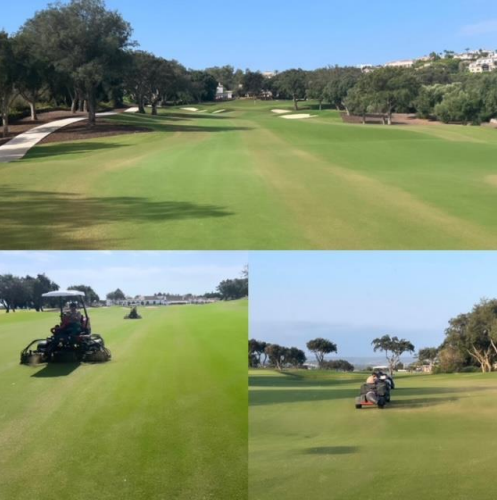
Another very important reason for the surface improvements this year is the commitment to light topdressing, this promotes smoother and firmer surfaces which is ultimately the goal

In mid – November we took the opportunity to mow the area down between the green and the lake on hole 9. This bermuda was soft, uneven and prone to weed ingress. We will agressively de-thatch this area in next years closures to further improve it. This will support the design philosophy allowing miss guided appraoch shots to punished and visually improve the area. The 8th was completed this year and whilst it makes it a little
more diffuclt the visual improvents are notable.

A few photos from October this year with the surfaces presenting well.


Hole 17

Hole 1

wild boar activity in the golf course has increased as we have moved out of summer, end of November saw them finally find their way into the turf. The area has been repaired and we have used some products with an odor to deter them from coming back.
regular fence checks are ongoing. This is a wider spread issue with the new course and resident lawns also suffering

our weekly/fortnightly stick edging work has helped reduce the bermuda encroachment into the bent this year

We are continually looking at trial options to improve what we currently do.
Top: herbicide application to prevent bermuda encroachment into the mulch and also spot spray any weeds growing in these areas.
Bottom Left: chemical trials on a product that reduces bermuda encroachment and doesn’t kill the bentgrass, this was positive but did cause some small injury. That said reduced rate and increased application intervals would be our next step for this.
Bottom right: preventative fungicide for the spring dead spot issue, 2 separate mixes were done on 8 fairway with an untreated section between them.
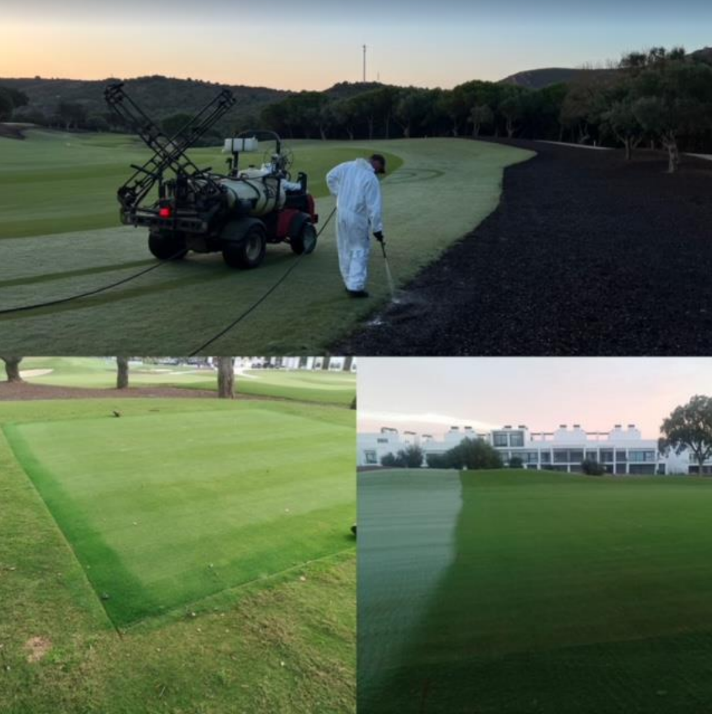
Below was the severity of the spring dead spot seen on 8 fairway in February this year. Efficacy of the trials will be seen as we go through winter.
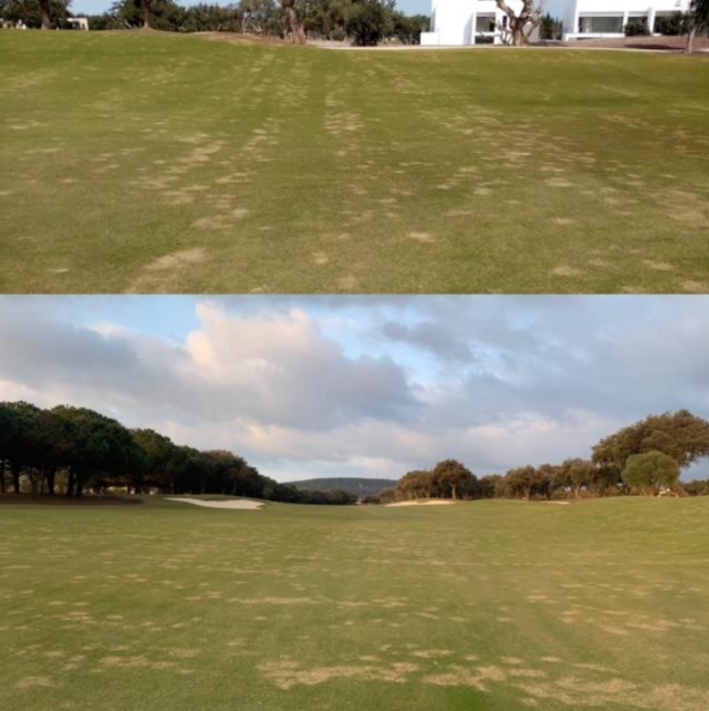
Some more comparions shots at the end of November 2021 vs 2022. Whilst this year has been slightly warmer, the turf being healthier is a contributing factor to difference also.
Hole 1

Hole 10

Hole 9

Hole 9

Other works
The team have tried to periodically get around to review the bunker levels and sand distribution. Based on member feedback we have a good idea of the problematic ones and these have had more intention than others
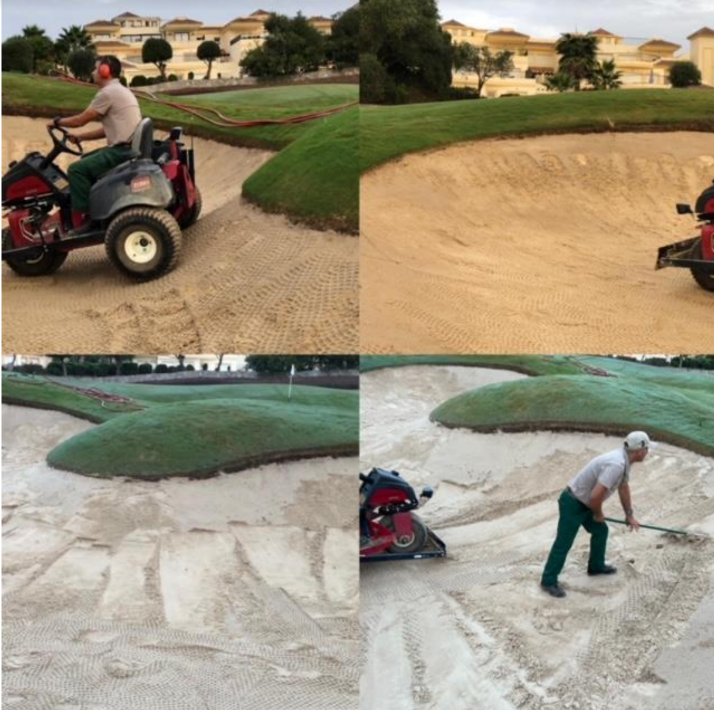
A few of the bunkers have had some sand added to improve visual appearance. 16th hole most notably. We will have a few bunkers over winter that we will empty to check and clean drainage to help improve some isolated situations. As touched on previously moisture content is the single biggest factor related to how the sand performs, some bunkers struggle based on the irrigation spacing and get more water


Club house lawns have also been overseeded with perennial ryegrass to improve the presentation of these areas.


When we’ve had time, we’ve also invested lots of effort into improving our maintenance area, this trend is planned to continue in 2023.. These changes are to improve the areas we work from, bring some areas up to new legal legislations and generally install much better ownership of our area and our assets.
We extended the mechanics office to allow an area for proper stock storage and control

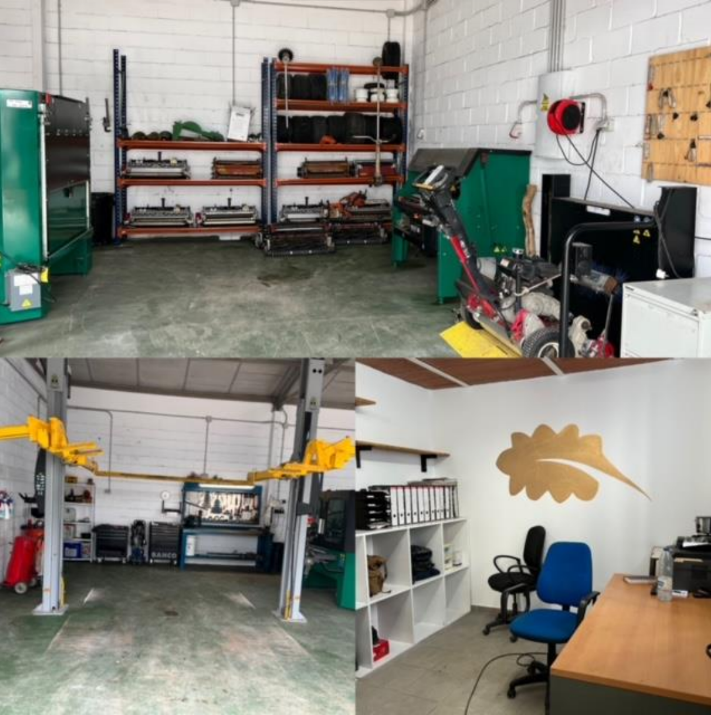
The chemical storage area getting some storage partitions, this is a new legal requirement for the storage of pesticides. All works have been completed in-house with our team. This isnt complete yet and works are still progressing.


Throughout November we have completed employee reviews for all staff, this is to review performance over the previous 12 months and discuss what we can do to help improve the staff and the department for next 12 months. These were very positive and an action plan will be drawn up for each individual. The collective agreement has also been finalized during November; this has been an ongoing process for many months but pleased with the outcome for the department. Many positive changes have been implemented for the staff and the operation.

The end of October we said goodbye to some of our summer casuals, they have been a welcome addition this year and it was good to give thanks and reflect on the improvements we have made on and off the course as a team.

New Course
The new course has shown some signs of improvements throughout the 2 nd half of the year. The staffing levels and agronomic inputs are not the same as the old course and this is the contributing to factor in the difference. The biggest challenge on the new course is the unpractical nature of its design, its age and the contamination of surfaces.
We overseed the new course tees with perennial ryegrass during November. Doing half of the tees, then the other half 3 weeks later. These established well and will allow the tees to present better for the winter.

Few photos below are the warm season weeds dying out as we approach winter, these leave voids which we are trying to fertilize and topdress to push surface recovery and improve playability.




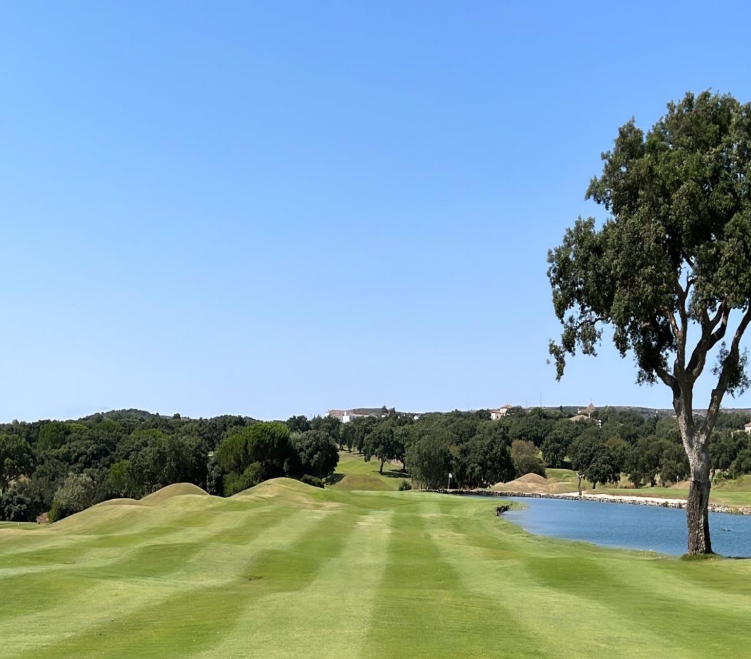
Winter projects
– Irrigation adjustments – throughout the winter you will see the irrigation team moving multiple sprinklers, adding sprinklers and in some cases removing them.
Many areas around the edges of the turf and cart paths are not uniformly spaced.
This will help in the summer months and also reduce some of the dry areas we suffer from in summer.
– Mulch area improvements – many areas around the golf course we have mulch applied on top of sand which creates issues for carts and can leave some of these areas very uneven and difficult to play from. the best example of this would be left of the path on hole 6. The plan for these area’s will be to remove the mulch,
remove the sand and replace with a more soil based sub-base then reinstate the mulch. This will leave these areas much firmer, less rutting from carts and generally much more presentable and easier to play from.
– Additional teeing areas – we have identified the need for some additional teeing areas on 9 out of the 18 holes to help spread the wear. At present we are struggling to find a contractor to complete these as well as the bentgrass sod for placing on the new tees. If we can’t achieve it this year, we would look to do these works the following winter.
– Course marker and furniture work – new tee markers, solid bases for all bins and water platforms, solid bases for all benches.
– Shaping of mulch areas to help direct the movement of water better. This is on various holes
As always if there are any questions related to the golf course, feel free to stop me when you see me around the golf course or club or you can contact me via email.
Thank you for your continued support throughout this year and wishing you a good festive period and happy new year.
Best regards,
Ben
Benjamin Griffiths
Director of Agronomy
doa@sanroqueclub.com




